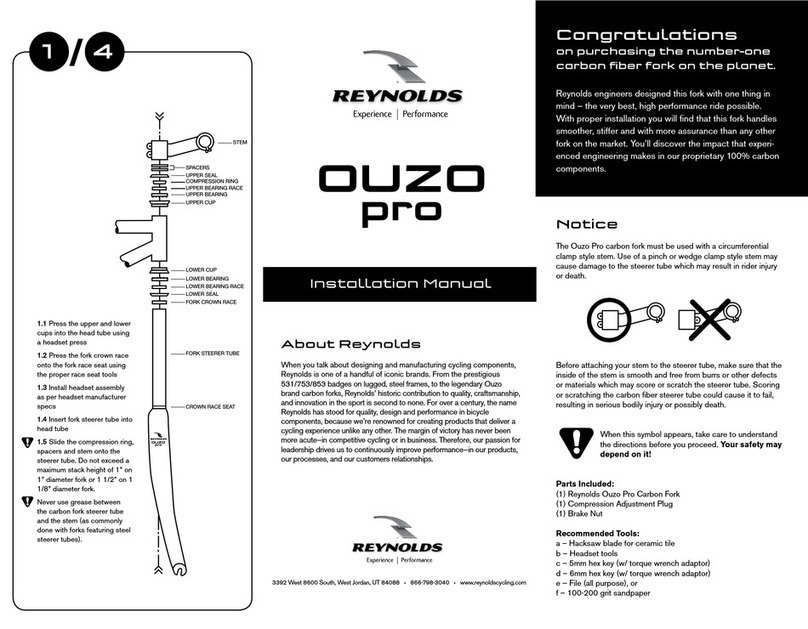
ReynoldsCycling.com 1
MECHANIC QUALIFICATION
Please be advised that many bicycle service and repair tasks require specialized knowledge, tools and
experience. General mechanical aptitude may not be sufficient to properly service or repair your bicycle
and/or Reynolds wheels. If you have any doubt regarding your service or repair ability, please take your
bicycle to a qualified mechanic or an authorized Reynolds dealer/distributor.
INTENDED USE
• Useofroadwheels: For road racing or general cycling on smooth, dry road surfaces only.
Not intended for use on motorized vehicles or for use on vehicles carrying more than one
operator/rider.
• Useofmountainwheels: Only use on open, and approved, trails and public lands.
Not intended for use on motorized vehicles or for use on vehicles carrying more than one
operator/rider. Any such use constitutes misuse which will void the Reynolds warranty and
may result in an accident, serious personal injury, death or property damage.
COMPONENT WEAR INSPECTION REQUIREMENT
The longevity of your Reynolds wheels depends on many factors. Factors that will determining their
longevity are: rider size and riding style, environmental conditions, tire specifications and air pressure, terrain
and geography, cleanliness and maintenance, brake pad composition, and impacts or falls. Improper or
harsh use may also compromise the structural integrity and significantly reduce the lifespan of your wheels.
Some components of the wheels are subject to wear over time and are not covered under warranty because
this is not due to defect. These items not covered under warranty due to normal wear and tear include:
bearings, brake pads and rim braking surface. Use only Reynolds recommended brake pads. Perform routine
maintenance and cleaning on brake pads and braking surface of rim.
Forcareandusagerecommendations,seeSection8ofthismanualorrefertotheReynoldswebsiteat
www.reynoldscycling.com/maintenance.
Have your wheels regularly inspected by a qualified mechanic for impact and stress marks, cracks,
deformations, and signs of fatigue or wear. If the inspection reveals any damage, no matter how slight,
immediately replace the component. Components that have experienced excessive wear also need
immediate replacement. Frequency of inspection depends on many factors; see Section 8 of this manual
for further assistance. Contact your authorized Reynolds dealer/distributor for suggested inspection/
maintenance schedule that is best fit for your use, riding style and conditions. If you weigh 82kg/180 lbs or
more, you must be especially vigilant and have your bicycle and components inspected more frequently.
Before using Reynolds wheels please recognize that there are risks inherent in bicycle riding. A bicycle
component can fail while riding resulting in an accident, injury or possibly death. By your purchase and use
of Reynolds wheels you expressly, voluntarily and knowingly accept and assume these risks including,
but not limited to: the risk of passive or active negligence of Reynolds or hidden, latent or obvious defect
in the product. Furthermore, you agree to hold Reynolds harmless to the fullest extent permitted by law
against any resulting damages.
WARNING: Failure to follow any of the instructions in this manual could result in failure of the
product, resulting in an accident, personal injury or death.
Ifyouhaveanyquestionspleasecontactanauthorizeddealer/distributoror
Reynoldscustomerserviceat866-798-3040;info@reynoldscycling.com.




























